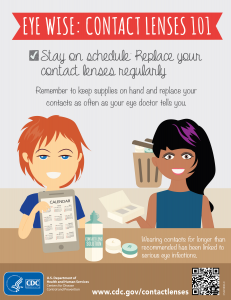When faced with how best to correct vision issues, your main options are wearing glasses or contact lenses (surgery is physically invasive and costly). While the variety of glasses are primarily fashion-oriented or purposed-oriented (i.e., sports, sunglasses, etc.), contact lens options tend to be time-oriented, as in, how long you can wear them before changing them out and cleaning them.
The American Optometric Association identifies five different types of contact lenses:
- Rigid gas-permeable (RGP): Made of slightly flexible plastic that allows oxygen to pass through to the eyes. Corrects most vision problems but debris can sometimes get under the lenses, causing infection or injury.
- Daily wear soft: Made of soft, flexible plastic that also allows oxygen to pass through to the eyes. Available in lenses that do not need to be cleaned (disposable). They don’t correct all vision issues, however.
- Extended-wear: Available for overnight wear in soft or RGP lenses. Can be worn up to seven days without removal. May cause infection.
- Extended-wear disposable: Soft lenses worn for extended periods of time (usually one to six days), then discarded. May cause infection.
- Planned replacement: Soft daily wear lenses replaced on a planned schedule, most often either every two weeks, monthly, or quarterly.
“Daily disposable contacts are healthier/better for your eyes than the two-week or monthly lenses,” says Dr. Cheryl Roell, optometrist and co-owner of All About Eyes. “We try to prescribe dailies for everyone, but especially all the kids/teens in our practice, for the health benefit as well as the ease of care. There is a higher percentage of eye infections and irritations with longer-wear contacts.”
Eye infection, known as keratitis, is an inflammation of the cornea (the clear dome that covers the colored part of the eye), notes the Centers for Disease Control (CDC) on their website. Keratitis happens when contact lens wearers don’t clean their lenses as instructed and germs get on the lenses — and are then transferred onto the cornea — causing the infection.
Disposed of after each use, daily wear contact lenses reduce the chances of infection. Note that disposable lenses should be thrown away in the trash, not flushed down the toilet or washed down the sink, as that causes environmental problems.
Other benefits to wearing daily wear contact lenses include feeling better about your appearance, they’re excellent for participating in sporting activities, and they don’t fog up in sudden temperature changes or get smudged. And because the lenses move with your eyes, side vision tends to improve, and there aren’t any frames getting in the way of your vision. In other words, they offer a more natural vision experience to wearing glasses.
If you are interested in trying out daily wear contact lenses, please contact either Dr. Cheryl or Dr. David Roell for an appointment to learn more about this option.


